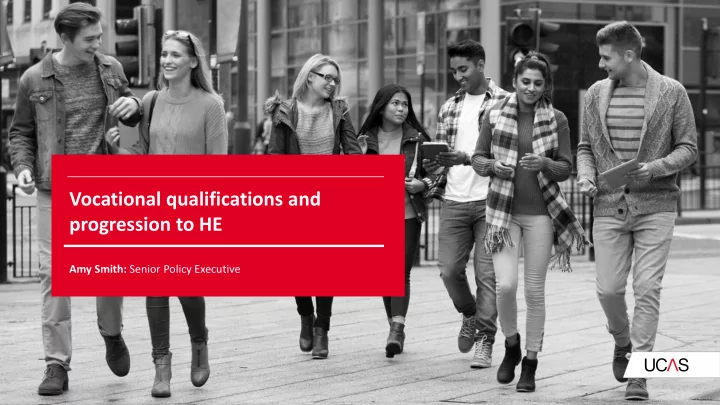

Click to edit Master title style • Click to edit Master text styles • Second level • Third level • Fourth level Vocational qualifications and • Fifth level progression to HE Amy Smith: Senior Policy Executive 9/25/2018 1
Entry rates consistent • The entry rate for A level only students has been increasing since 2014 but slowed in 2017 to reach 20.5%. • Entry rates for BTEC and combination of A Level and BTEC both increased by 0.1 percentage points. • Entry rates are largely stable for students holding SQAs and IB.
Average attainment levels • BTECs have the lowest attainment but saw largest increase from last year from 11 points to 11.3. • A level attainment has been gradually decreasing from 12 points in 2012 to 11.8 in 2017.
Who are BTEC students? UK 18 year old accepted applicants by POLAR3 (2017) • More likely to be POLAR3 Q1 and Q2. • More likely to be Black or Asian. • More likely to enter lower tariff providers, followed by medium, then higher tariff providers. • 49.7% of BTEC applicants with D*D*D* placed at lower tariff providers.
Qualification provision survey: findings 5
Qualification reform roundtable: January 2018 About the event Key findings • • A forum to reflect on how the education An unprecedented level of change – sector was prepared for, and responded careful preparation, communication and to, qualification reform. support needed for further changes. • • Focused on lessons learned and sought Some challenges mitigated by increased to identify the most supportive activities HE competition and the declining 18-year- and resources. old population. • • Survey was very useful in showing how UCAS should continue to play a central role the pre-HE sector responds to the in communicating intelligence . reforms; the expanded UK-wide survey • Qualification reform statements are key will continue. resource for schools and colleges.
Response across the UK
Vocational qualification coverage
England: vocational qualifications
Feedback on the delivery of vocational qualifications
Qualification provision survey: recommendations 11
Recommendations: schools and colleges • Engage with universities and colleges to understand their response to qualification reform. • Ensure the qualification shortlist in UCAS Apply is accurate. • Use the UCAS reference to provide additional information on curriculum provision. • Work with UCAS to provide insight into curriculum provision across the UK.
Recommendations: universities and colleges • Produce/update existing qualification reform statements . • Ensure entry requirements are clear and transparent. • Make sure offers are clear and relevant to individual students. • Provide clear entry requirements and supporting information for vocational qualifications . • Engage with schools and colleges to understand their response to reforms. • Clearly communicate any changes to the suitability of qualifications for entry.
Recommendations: UCAS • Continue to take a central role in communicating intelligence regarding qualification reform. • Provide comprehensive I&A for a broad range of qualifications for all audiences. • Issue the UK-wide qualification provision survey annually. • Reflect the range of qualifications (and their differences) in current and new UCAS services. • Ensure that changes to qualifications central when developing new products and services.
Qualification reform and 2018 entry 15
What was new for 2018? • Ongoing introduction of reformed A levels across the UK, including additional subjects in England, and CCEA regulated A levels in Northern Ireland. • Growing number of reformed GCSEs (9 – 1) entering HE. • First substantive award of new style vocational qualifications.
Vocational qualification reform: key issues • Dual running – applicants may declare the incorrect version on their application. • Different skills and aptitudes shown. • Assessment changes – both external and synoptic assessment, as well as changes to resit processes. • Fewer students passing the qualification, and changes to grade distribution. • Greater need for differentiation at Confirmation/Clearing could lead to delayed decisions.
UCAS support • Range of information and advice for all audiences. • Regular communications. • Engagement with awarding organisations and regulators to ensure up to date on changes (including the ‘must pass’ changes). • ABL and results processing changes. • Emphasis on reformed vocational qualifications in results embargo training. • Intelligence gathering and dissemination, including our qualification provision survey.
Looking forward to 2019 19
Qualification reform in 2019 GCSEs in Northern Ireland • Introduction of the C* grade, aligned to grade 5 on the 9-1 scale • Grade B now aligns to grade 6 • A* aligns to grade 9 • UCAS is engaging with CCEA around messaging and support for HE providers in setting entry requirements Key issues for HE providers: • Fewer students achieving grade B and grade A* – impact on HE providers' entry requirements. • Students in Wales will continue to follow A*-G but will not align with the Northern Irish scale. • No direct equivalence with grade 8.
Qualification reform in 2019 Forthcoming changes include: • Continued rollout of reformed A levels and GCSEs • Functional skills qualifications: awareness raising with HE providers • Further vocational reform: Level 4 and 5 review, Applied Generals, and Level 2 vocational qualifications? • Continued apprenticeship standards development.
Looking beyond 2019: T Levels How UCAS is supporting: • Consultation response (early 2018). • Engaging with the Department for Education and Institute for Apprenticeships regarding T Level content. • Sharing T Level content and I&A as it is developed. • UCAS Tariff points and T Levels. Key issues for HE providers: • The importance of a bridging provision between academic and vocational routes at Level 3. • Suitability of T Levels for progression to HE. • Differences in content between T Levels – is the core transferable? • Different grading structures.
Thank you Email: a.smith@ucas.ac.uk 23
Recommend
More recommend